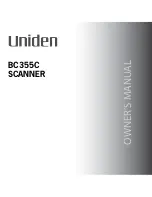
88
Digital Operation
Your scanner is equipped with advanced Digital Signal Processing circuitry to receive
and decode Phase 1 APCO-25 C4FM (four level FM) digital voice transmissions. This
section of the manual will help you understand the differences between traditional analog
and digital modulation.
For ease of use, your scanner is designed to automatically detect digital modulation on
any conventional channel programmed for FM/Digital (FM) modulation. It is not
necessary to configure individual channels for digital operation.
Many digital trunked radio systems are actually mixed mode systems that support both
analog and digital modulation. Certain user groups on these systems may use analog
modulation, while others use digital modulation. Your scanner will automatically detect
the type of modulation being used and switch to the correct modulation mode without
special programming or user intervention.
Your scanner also features Intelligent Adaptive Digital Tracking for optimal reception of
digital signals from a variety of digital conventional and trunked radio system types. No
special sound quality settings or adjustments are needed for different C4FM system
types.
Digital modulation represents a breakthrough in public safety communications
technology. Digital modulation typically provides a clear, distortion free audio signal
throughout the service area of the system you are monitoring. However, there are some
important differences between analog and digital voice performance that you should be
aware of while scanning.
In most cases, digital voice transmissions will be surprisingly crisp and clear, and without
noise or distortion, even when corresponding analog signals from the same system
contain some static. However, if you are in a location with marginal reception, you may
find that the voice quality of digital signals deteriorates very rapidly, resulting in missing
syllables or entire words. If this happens, try reorienting the scanner or antenna for better
reception. You may also try pressing the ATT key and apply attenuation to reduce the
overload effects of nearby strong transmitters.
Under certain very weak digital signal conditions, the scanner may lose synchronization
with the digital signal and briefly revert to analog FM, resulting in the reception of the raw,
















































